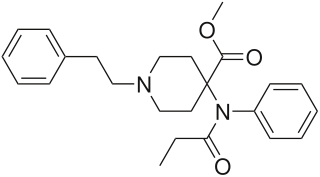Related Research Articles

Oxycodone, sold under various brand names such as Roxicodone and OxyContin, is a semi-synthetic opioid used medically for treatment of moderate to severe pain. It is highly addictive and is a commonly abused drug. It is usually taken by mouth, and is available in immediate-release and controlled-release formulations. Onset of pain relief typically begins within fifteen minutes and lasts for up to six hours with the immediate-release formulation. In the United Kingdom, it is available by injection. Combination products are also available with paracetamol (acetaminophen), ibuprofen, naloxone, naltrexone, and aspirin.

Fentanyl, also spelled fentanil, is a highly potent synthetic piperidine opioid drug primarily used as an analgesic. Because fentanyl is 50 to 100 times more potent than morphine, its primary clinical utility is in pain management for cancer patients and those recovering from painful surgical operations. Fentanyl is also used as a sedative. Depending on the method of delivery, fentanyl can be very fast acting and ingesting a relatively small quantity can cause overdose. Fentanyl works by activating mu-opioid receptors. Fentanyl is also commonly known as fentanyl citrate and is sold under the brand name Sublimaze, among others.

Naloxone is a medication used to reverse or reduce the effects of opioids. It is used to counter decreased breathing in opioid overdose. Effects begin within two minutes when given intravenously, five minutes when injected into a muscle, and ten minutes as a nasal spray. Naloxone blocks the effects of opioids for 30 to 90 minutes.

A drug overdose is the ingestion or application of a drug or other substance in quantities much greater than are recommended. Typically it is used for cases when a risk to health will potentially result. An overdose may result in a toxic state or death.

Speedball, powerball, or over and under, is the polydrug mixture of a stimulant with a depressant, usually an opioid.

Carfentanil or carfentanyl, sold under the brand name Wildnil, is an extremely potent opioid analgesic which is used in veterinary medicine to anesthetize large animals such as elephants and rhinoceroses. It is typically administered in this context by tranquilizer dart. Carfentanil has also been used in humans for imaging of opioid receptors. It has additionally been used as a recreational drug, typically by injection, insufflation, or inhalation. Deaths have been reported in association with carfentanil.

Sufentanil, sold under the brand names Dsuvia and Sufenta, is a synthetic opioid analgesic drug approximately 5 to 10 times as potent as its parent drug, fentanyl, and 500 times as potent as morphine. Structurally, sufentanil differs from fentanyl through the addition of a methoxymethyl group on the piperidine ring, and the replacement of the phenyl ring by thiophene. Sufentanil first was synthesized at Janssen Pharmaceutica in 1974.
Gray death is a slang term which refers to a potent mixture of synthetic opioids, for example benzimidazole opioids or fentanyl analogues, often sold on the street as a proven substance. However, other substances such as stimulants have also been laced with opioids that resulted in deaths.
Kolokol-1 is a synthetic opioid developed for use as an aerosolizable incapacitating agent. The exact chemical structure has not yet been revealed by the Russian government. It was originally thought by some sources to be a derivative of the potent opioid fentanyl, most probably 3-methylfentanyl dissolved in an inhalational anaesthetic as an organic solvent. However, independent analysis of residues on the Moscow theater hostage crisis hostages' clothing or in one hostage's urine found no fentanyl or 3-methylfentanyl. Two much more potent and shorter-acting agents, carfentanil and remifentanil, were found in the samples. They concluded that the agent used in the Moscow theater hostage crisis contained two fentanyl derivatives much stronger than fentanyl itself, sprayed in an aerosol mist.

α-Methylfentanyl an opioid analgesic that is an analog of fentanyl. It is sometimes sold as "China White".

An opioid overdose is toxicity due to excessive consumption of opioids, such as morphine, codeine, heroin, fentanyl, tramadol, and methadone. This preventable pathology can be fatal if it leads to respiratory depression, a lethal condition that can cause hypoxia from slow and shallow breathing. Other symptoms include small pupils, and unconsciousness, however its onset can depend on the method of ingestion, the dosage and individual risk factors. Although there were over 110,000 deaths in 2017 due to opioids, individuals who survived also faced adverse complications, including permanent brain damage.

Acetylfentanyl is an opioid analgesic drug that is an analog of fentanyl. Studies have estimated acetylfentanyl to be fifteen times more potent than morphine, which would mean that despite being somewhat weaker than fentanyl, it is nevertheless still several times stronger than pure heroin. It has never been licensed for medical use and instead has only been sold as a designer drug. Acetylfentanyl was discovered at the same time as fentanyl itself and had only rarely been encountered on the illicit market in the late 1980s. However, in 2013, Canadian police seized 3 kilograms of acetylfentanyl. As a μ-opioid receptor agonist, acetylfentanyl may serve as a direct substitute for heroin or other opioids. Common side effects of fentanyl analogs are similar to those of fentanyl itself, which include itching, nausea and potentially serious respiratory depression, which can be life-threatening. Fentanyl analogs have killed hundreds of people throughout Europe and the former Soviet republics since the most recent resurgence in use began in Estonia in the early 2000s, and novel derivatives continue to appear.
Jack Fishman, born Jacob Fiszman, was a Jewish-American pharmaceutical researcher from Kraków, Poland. In 1961, along with Mozes J. Lewenstein, he developed the medication naloxone, which can reverse an opioid overdose, and the Centers for Disease Control and Prevention has described as a "a life-saving medication that can reverse an overdose from opioids—including heroin, fentanyl, and prescription opioid medications."
Brandon del Pozo, PhD, MPA, MA is an assistant professor of Medicine and Health Services, Policy, and Practice (Research) at the Warren Alpert Medical School of Brown University, and a research scientist at Rhode Island Hospital. He is also a faculty member of the Master of Science Program in Addiction Policy and Practice at the Georgetown University's Graduate School of Arts and Sciences.

In the United States, the opioid epidemic is an extensive, ongoing overuse of opioid medications, both from medical prescriptions and illegal sources. The epidemic began in the United States in the late 1990s, according to the Centers for Disease Control and Prevention (CDC), when opioids were increasingly prescribed for pain management, resulting in a rise in overall opioid use throughout subsequent years. The great majority of Americans who use prescription opioids do not believe that they are misusing them.

The opioid epidemic, also referred to as the opioid crisis, is the rapid increase in the overuse, misuse/abuse, and overdose deaths attributed either in part or in whole to the class of drugs called opiates/opioids since the 1990s. It includes the significant medical, social, psychological, demographic and economic consequences of the medical, non-medical, and recreational abuse of these medications.

The United States Centers for Disease Control and Prevention has data on drug overdose death rates and totals. Around 1,106,900 US residents died from drug overdoses from 1968 to 2020. Around 932,400 from 1999 through 2020. Around 91,800 in 2020. 28 people out of every 100,000 died from drug overdoses in 2020 in the US. Opioids were involved in around 80,400 of the around 106,700 deaths in 2021. Synthetic opioids other than methadone were involved with 70,601 deaths in 2021.

New Jersey's most recent revised policy was issued September 7, 2022 pursuant to P.L.2021, c.152 which authorized opioid antidotes to be dispensed without a prescription or fee. Its goal is to make opioid antidotes widely available, reducing mortality from overdose while decreasing morbidity in conjunction with sterile needle access, fentanyl test strips, and substance use treatment programs. A $67 million grant provided by the Department of Health and Human Services provides funding for naloxone as well as recovery services. This policy enables any person to distribute an opioid antidote to someone they deem at risk of an opioid overdose, alongside information regarding: opioid overdose prevention and recognition, the administration of naloxone, circumstances that warrant calling 911 for assistance with an opioid overdose, and contraindications of naloxone. Instructions on how to perform resuscitation and the appropriate care of an overdose victim after the administration of an opioid antidote should also be included. Community first aid squads, professional organizations, police departments, and emergency departments are required to "leave-behind" naloxone and information with every person who overdosed or is at risk of overdosing.
Since 2017, the number of California state fatalities attributable to synthetic opioids has increased by 1,027%. Fentanyl has been to blame for 20% of deaths among California's teenagers and young adults. California is taking legal efforts to tackle the opioid issue, including patrols, assistance grants, and education.
In response to the surging opioid prescription rates by health care providers that contributed to the opioid epidemic in the United States, US states began passing legislation to stifle high-risk prescribing practices. These new laws fell primarily into one of the following four categories:
- Prescription Drug Monitoring Program (PDMP) enrollment laws: prescribers must enroll in their state's PDMP, an electronic database containing a record of all patients' controlled substance prescriptions
- PDMP query laws: prescribers must check the PDMP before prescribing an opioid
- Opioid prescribing cap laws: opioid prescriptions cannot exceed designated doses or durations
- Pill mill laws: pain clinics are closely regulated and monitored to minimize the prescription of opioids non-medically
References
- 1 2 Hoogensen, Finn (September 18, 2023). "Fentanyl found where kids slept at Bronx day care: police". PIX11. Retrieved October 15, 2023.
- 1 2 3 4 "NYC daycare tried to cover up fentanyl operation before 1yo's death". 1 News. Retrieved September 20, 2023.
- 1 2 3 4 5 6 7 8 9 "US child dies from fentanyl kept under nursery nap mat". BBC News. September 19, 2023. Retrieved September 20, 2023.
- ↑ "Husband of New York City day care owner arrested in child's fentanyl death - CBS New York". www.cbsnews.com. September 26, 2023. Retrieved October 1, 2023.
- ↑ "Fentanil: a chocante morte de criança por suspeita de overdose em creche de Nova York". G1 (in Portuguese). September 21, 2023. Retrieved September 22, 2023.
- ↑ Morales, Mark (September 21, 2023). "NYPD finds trap door and drugs hidden in floor at Bronx day care where 1-year-old died of suspected fentanyl overdose". CNN. Retrieved September 23, 2023.
- ↑ "Toddler's death at New York City day care caused by fentanyl overdose, autopsy finds - CBS News". www.cbsnews.com. September 29, 2023. Retrieved October 1, 2023.